Sample Sample Sample
"Sample" is somewhat of a dirty word. It's the answer to many a weaving question, we know it's the answer, and yet we resist. We ask anyway.
"How will this yarn work at this sett?"
"How should I wash the fabric I've woven?"
"What color should I use?"
"How does this weave structure compare with this one?"
We can all give an answer. Weaving and the end result we are seeking is so vast and varied though, the answer we give, while it may be totally correct, may not be the "right" answer.
And so we sample. But how? Well, I have 2 absolute rules:
#1: always weave the sample on the equipment you will use to weave the project.
This may seem obvious, but it bears repeating. A sample woven on a rigid heddle loom does not give accurate information if your project, even woven at the same width and sett, is woven on a floor loom. The yarns will be under different tension. The beater and consequently the beat, will vary. The depth of the shed will vary. And, importantly here: the rigid heddle loom raises and lowers one set of warps, leaving the other (the slotted warps) static: not moving, never rising or sinking. This means a variation, a differentiation, in warp tension due to the very mechanism itself.
Pin loom weaving is not a sample for fabric woven on any loom: it's an alternative type of weaving. The warp and weft of a pin loom (or of a triangle loom) intermingle in ways not done on a rigid heddle, table or floor loom. There is only the tension the weaver applies, there is no beater, and there is no shed.
Rule #2: determine what you are sampling for....
If I am sampling for sett choice, weave structure, weft choice or yarn suitability, or how the fabric will finish, I simply add an extra yard in length to the warp. With that extra length, I can do a series a samples, still using the same equipment as the final piece. I can test wefts for color and size, I can test for beat: double? open shed? closed shed? I can sample weave structures, and re-thread or re-tie if needed. I can cut off and wash a sample, and still have room to re-tie and weave the project. A few inches of warp is sometimes all I will need:
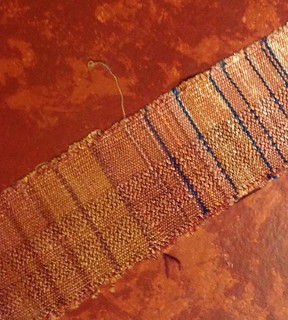
In the small space of 2", this sample tells me 4 things: choice of weft (finer, singles silk noil), color of weft (gold, not purple), manner of beating (double beat), and weave structure (plain weave, not broken twill). Since I put on a bit more than this 2" for sampling, I also ended up with a generous length of fabric left over, never a bad thing.
But if I am weaving to test the drape of the fabric, my sample will be bigger. I need a big enough length to wash and press, and then test for drape. A little square, even an extra yard won't really do. In this case, I am testing a new weft (singles fine wool):
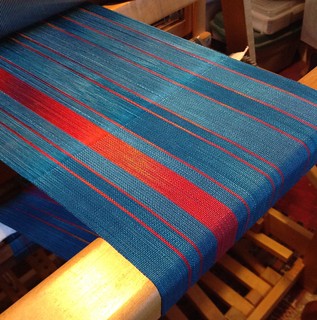
So lots of my samples are scarves or shawls. They can vary so much in qualities like thickness, fulling, width and length, and color arrangement that a full length sample tested in real life is never a bad idea. These samples also help me determine how much fiber I will need for the finished project: how much do I need to buy or spin? I end up with lots of samples:
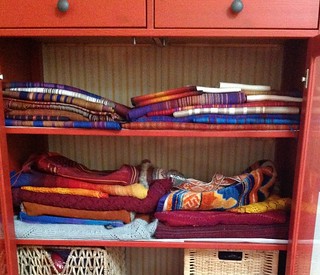
Drape is important in the fabrics that I make. My warp-dominant fabrics could be stiff and boardy, so the components: sett and weft are critical. But not "to the eye" critical: to the hand. To feel. After finishing. In use. Scarves and shawls get used. Yarn and sett get assessed. The the final fabric gets woven:
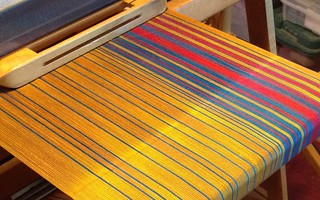
So think big. Buy extra fiber or yarn, beyond just the minimum amount you think you will need. Make samples that will be useful, depending on the quality you are sampling for. Samples are not a waste of time and materials, they are tools. They are tools I need to use to learn how best to make the finished fabric.
Since I am learning new skills in leather stitching, I've had to make samples here too:
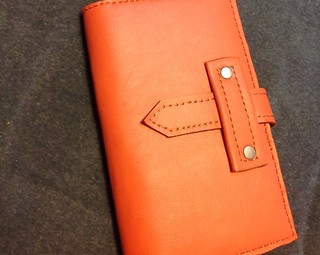
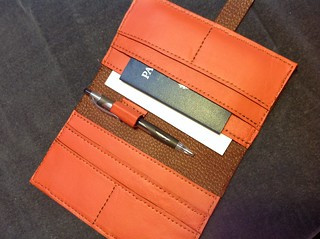
Testing color and thickness of the leather, a new-to-me thread, finish choices and size choices: the same types of things I need to sample in weaving. Also? skill building: the more I make, the more my hands learn what to do. The more I make, the better decisions I can make next time.
It's all a process, It's all time and materials well spent. Sometimes, the sample is enough:
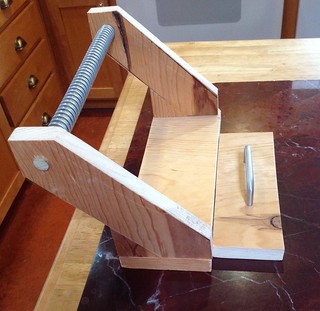
Not pretty, made of scrap wood. But it should be a functional tool! I have no plans to be a woodworker, but I did want a small tablet weaving loom. The sample is the project, in this case, and I am off to try out the results today! Wish me luck!
"How will this yarn work at this sett?"
"How should I wash the fabric I've woven?"
"What color should I use?"
"How does this weave structure compare with this one?"
We can all give an answer. Weaving and the end result we are seeking is so vast and varied though, the answer we give, while it may be totally correct, may not be the "right" answer.
And so we sample. But how? Well, I have 2 absolute rules:
#1: always weave the sample on the equipment you will use to weave the project.
This may seem obvious, but it bears repeating. A sample woven on a rigid heddle loom does not give accurate information if your project, even woven at the same width and sett, is woven on a floor loom. The yarns will be under different tension. The beater and consequently the beat, will vary. The depth of the shed will vary. And, importantly here: the rigid heddle loom raises and lowers one set of warps, leaving the other (the slotted warps) static: not moving, never rising or sinking. This means a variation, a differentiation, in warp tension due to the very mechanism itself.
Pin loom weaving is not a sample for fabric woven on any loom: it's an alternative type of weaving. The warp and weft of a pin loom (or of a triangle loom) intermingle in ways not done on a rigid heddle, table or floor loom. There is only the tension the weaver applies, there is no beater, and there is no shed.
Rule #2: determine what you are sampling for....
If I am sampling for sett choice, weave structure, weft choice or yarn suitability, or how the fabric will finish, I simply add an extra yard in length to the warp. With that extra length, I can do a series a samples, still using the same equipment as the final piece. I can test wefts for color and size, I can test for beat: double? open shed? closed shed? I can sample weave structures, and re-thread or re-tie if needed. I can cut off and wash a sample, and still have room to re-tie and weave the project. A few inches of warp is sometimes all I will need:

In the small space of 2", this sample tells me 4 things: choice of weft (finer, singles silk noil), color of weft (gold, not purple), manner of beating (double beat), and weave structure (plain weave, not broken twill). Since I put on a bit more than this 2" for sampling, I also ended up with a generous length of fabric left over, never a bad thing.
But if I am weaving to test the drape of the fabric, my sample will be bigger. I need a big enough length to wash and press, and then test for drape. A little square, even an extra yard won't really do. In this case, I am testing a new weft (singles fine wool):

So lots of my samples are scarves or shawls. They can vary so much in qualities like thickness, fulling, width and length, and color arrangement that a full length sample tested in real life is never a bad idea. These samples also help me determine how much fiber I will need for the finished project: how much do I need to buy or spin? I end up with lots of samples:

Drape is important in the fabrics that I make. My warp-dominant fabrics could be stiff and boardy, so the components: sett and weft are critical. But not "to the eye" critical: to the hand. To feel. After finishing. In use. Scarves and shawls get used. Yarn and sett get assessed. The the final fabric gets woven:

So think big. Buy extra fiber or yarn, beyond just the minimum amount you think you will need. Make samples that will be useful, depending on the quality you are sampling for. Samples are not a waste of time and materials, they are tools. They are tools I need to use to learn how best to make the finished fabric.
Since I am learning new skills in leather stitching, I've had to make samples here too:


Testing color and thickness of the leather, a new-to-me thread, finish choices and size choices: the same types of things I need to sample in weaving. Also? skill building: the more I make, the more my hands learn what to do. The more I make, the better decisions I can make next time.
It's all a process, It's all time and materials well spent. Sometimes, the sample is enough:

Not pretty, made of scrap wood. But it should be a functional tool! I have no plans to be a woodworker, but I did want a small tablet weaving loom. The sample is the project, in this case, and I am off to try out the results today! Wish me luck!

4 Comments:
one more thing one gets from sampling....
Skills!
So you went with the angled back beam; will be interested to know what you think. And, I've discovered that I have a yard full of porcelain insulators. Who knew?
I must - simply MUST - get rid of everything in the way of sampling, playing, exploring, experimenting. It's driving me crazy not to play! (as I'm sure you've noticed) (and you would have loved Ruby Leslie's samples)
I recently found the Harrisville EasyLoom makes a good little tablet loom. They are easy to find used. With the slot in the base I can even hang it on the wall between sessions. PS Thanks for your 2006 post on spinning wool warp, it's how I came to your blog.
Post a Comment
<< Home